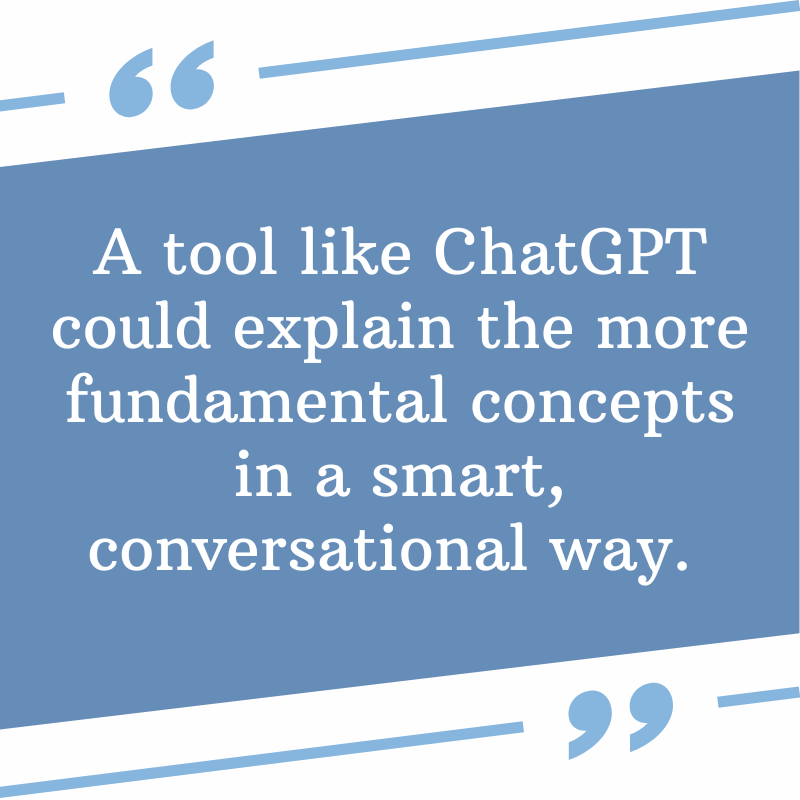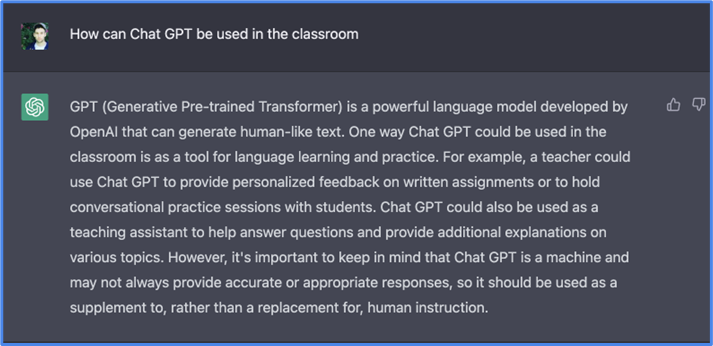Rather than ask “friend or foe?” teachers should consider the benefits of a process-based approach, facilitated by AI
In the past several weeks, it’s been impossible to avoid discussions in the education space around ChatGPT1―the newly unveiled chatbot from Open AI―and its implications for the future of teaching and learning. ChatGPT is unlike any previous incarnation of chatbots that seemed clunky and mostly visible as online customer service bots answering yes-or-no questions, directing you to an FAQ page of a corporate website, or asking you to wait for a live human to help.
The real innovation is that ChatGPT speaks in truly conversational language: not just scouring the Internet for search results through SEO or connecting you to links it thinks will help you. Machine learning has taught the ChatGPT interface to synthesize huge volumes of data, and to interact with users by actually answering their questions―not just directing them to a webpage that may or may not do so. Almost immediately, teachers and administrators started to share their thoughts2 on how this fundamental change might impact student learning―and most of the debate focused on the topic of cheating3. Many educators were concerned that students would merely use ChatGPT to answer questions or respond to writing prompts for them, tricking teachers into thinking it was their work they were submitting, not that of the chatbot.

Having taught 6th Social Studies for many years, I have considerable experience with what potential cheating looks like in the Humanities. That said, focusing on the issue of cheating is misguided for a couple of reasons. It implies that the work product―like a written essay, for example―is the summation of a student’s learning and that the relationship between teachers and AI is therefore adversarial. The greater danger is that in worrying so much about how students might cheat, we risk missing the truly transformative benefits that technology like ChatGPT represents. While this specific tech tool is still in its early stages, the potential is already overwhelming the conversation about the future of instruction for students at all levels. What I see as missing from the conversation is how the use of ChatGPT can help our teachers implement a much more process-oriented approach in their classrooms.
ChatGPT pushes us to a more process-oriented pedagogy
When I first started teaching back in the early 2000s, I was in charge of teaching multiplication facts to a roomful of 4th graders. Even then, there was great emphasis on memorization and rote repetition. It wasn’t far off from my own educational experience―chanting the “times tables” every afternoon as a 4th grader myself. Through the span of my career, I’ve seen movement towards a better understanding of how students actually learn, the importance of a flexible classroom space where there are multiple modes of instruction, and more focus on how kids can be lifelong learners rather than vessels to fill with finite amounts of facts and knowledge.
Among the elements of this movement have been frameworks like Backward Design4 for lesson planning, Universal Design for Learning (UDL5) for creating dynamic instructional spaces, and a shift away from summative assessments in favor of formative checks that track student progress. The power of these frameworks is in their student-centeredness. Instead of a Trivial Pursuit-style of learning and telling-back, teachers are now able to think about what students should know and be able to do as a result of their lessons, and then work backward from there. Along the journey, teachers are constantly evaluating in both formal and informal ways: checking for understanding, remediating when necessary, and allowing for the application of knowledge and practice of skills.
So what does this mean for the introduction of ChatGPT?
In an educational space that has long been moving away from memorization and basic understanding in favor of deeper learning and process orientation, ChatGPT allows this trend to continue―and accelerate. If I were teaching my middle school students about ancient Nubia, I would want them to have a foundational understanding of where the ancient kingdoms of Nubia were along the Nile and when their major time periods of development occurred. But that’s not the sum total of how I want them to understand Nubian cultures. Sure, a student may ask ChatGPT “Where was ancient Nubia?” and get an answer. That doesn’t mean that they’ve somehow bypassed the learning process. It doesn’t mean they’ve learned all that there is to understand about that particular topic, or the skills that go along with studying ancient civilizations, e.g., vetting reliable sources, interpreting primary source evidence, and thinking critically about what makes humanity happen. All of those skills would be the goals of a series of well-designed lessons. Just like a library of high-quality content, interactive assignments, formative assessments, and other instructional tools, I see ChatGPT as another useful resource. And, like any educational technology tool, it’s more about how teachers use it effectively rather than an inherent usefulness or potential for cheating.
ChatGPT and AI implications for saving teacher time

1. Allow ChatGPT to explain fundamental concepts to students before we ask them to think critically about higher-order concepts
An abundance of patience was central to my ability to teach middle school for two decades. That and a good sense of humor allowed me to continually answer questions―deep ones, simple ones, silly ones, and really insightful ones. Sometimes I would answer the same question multiple times in rapid succession. What I found was that the more basic questions―like “What should I label this on the map?”―took time away from deeper conversations with students that stemmed from questions like “Did Nubia influence Egypt, or did Egypt influence Nubia?”
From a pedagogical point of view, having a tool like ChatGPT explain the more fundamental concepts in a smart, conversational way would help students understand what they need to know before we ask them to think critically about higher-order concepts.
2. Ask students to evaluate a ChatGPT answer
Even in doing that, a simple activity that could turn the “cheating” argument on its head would be to ask students to evaluate a ChatGPT answer. A formative assessment may be to ask ChatGPT “Was Nubia a great civilization?” and then have groups of students evaluate the answer, using what they’ve learned through their classroom experience up to that point. ChatGPT is a tool to be harnessed, not feared. It also indicates the advancement of artificial intelligence that will most certainly continue. I remember when teachers once debated issues around online learning activities and devices in the classroom. Rather than try and hold back, we would do well to understand and adapt.
ChatGPT is in an early stage, with room for improvement
Does this mean that when we talk about ChatGPT, there aren’t legitimate concerns? Absolutely not. Like any artificial intelligence based on real human communication, ChatGPT has several elements that can still be problematic. On its face, it seems something like ChatGPT might replace a teacher, or provide a student’s work for them. This could never be the case, as true learning develops through relationships between teachers and students, and students and their peers. There are social and emotional aspects to the instructional experience that cannot be replicated by a call-and-response software program, no matter how sophisticated. The central element of an effective classroom is a great teacher who is simultaneously a coordinator of learning activities, a curator of high-quality, standards-aligned content, and a facilitator of a dynamic learning environment. The central figure in that environment is the student―both individually and as a social group.
That social dynamic is also related to some of the more problematic aspects of ChatGPT. There have been examples of stereotypes6 or propagation of certain racial biases in some of its answers. There have been examples7 where the answers are factually wrong or produce enough of a ‘word salad’ to be verbiage with little actual substance. But, honestly, we have lots of content that already displays inherent bias8, and every teacher has seen their share of ‘word salad’ from students. Instead of banning this technology, we should teach students how to recognize and mitigate these problems.
3. Reevaluate homework assignments that are already prone to cheating
We also need to reflect on the kinds of assignments we’re giving students, especially for homework. If an assignment is so prone to cheating that an entire field of emergent technology represents a threat, maybe it’s time to re-examine what we’re asking students to do. In doing so, we move further away from the rote memorization of facts and closer to a process-oriented approach.
4. Be ready for what comes next
We have only just begun to consider the effect that sophisticated AI, even in its early form, will have on the way we teach. But now is a good time to start putting in place the guardrails we want, examine how we can use AI’s potential effectively, and assess the benefits and drawbacks for students’ learning. Recently OpenAI, the creator of ChatGPT, has discussed9 selling shares in its business at a valuation of almost $30 billion. That value reflects the great potential for growth demonstrated by ChatGPT and its underlying technology. Even more relevant to the educational space, Microsoft is preparing to integrate ChatGPT functionality10 into its search engine, Bing. The most attractive element for Microsoft is the same that makes ChatGPT useful to students: it just answers the question, as opposed to serving up a menu of related links and advertisements. In that most basic regard, it’s an improvement on one of my middle schoolers’ favorite ways of finding something out: “I’ll just Google it.”
Finally, ChatGPT itself has a pretty great response to this question―especially the final caveat: “it’s important to keep in mind that ChatGPT is a machine and may not always provide accurate or appropriate responses, so it should be used as a supplement to, rather than a replacement for, human instruction.”

……….
1AP News, Matt O’Brien, “What is ChatGPT and why are schools blocking it?” January 6, 2023 https://apnews.com/article/what-is-chat-gpt-ac4967a4fb41fda31c4d27f015e32660
2Today.com Elise Sole, “Teachers sound off on ChatGPT, the new AI tool that can write students’ essays for them,” January 5, 2023 https://www.today.com/parents/teens/chatgpt-ai-teachers-students-cheat-essays-rcna63352
3Gizmodo.com, Lucas Ropek, “New York City Schools Ban ChatGPT to Head Off a Cheating Epidemic,” January 4, 2023 https://gizmodo.com/new-york-city-schools-chatgpt-ban-cheating-essay-openai-1849949384
4ACSD.org, Jay McTighe, “Backward Design for Forward Action,” February 1, 2003 https://www.ascd.org/el/articles/backward-design-for-forward-action
5 CAST (2018). “Universal Design for Learning Guidelines” version 2.2. Retrieved from http://udlguidelines.cast.org
6Bloomberg.com Davey Alba, “Open AI Chatbot Spits Out Biased Musings, Despite Guardrails,” December 8, 2022
https://www.bloomberg.com/news/newsletters/2022-12-08/chatgpt-open-ai-s-chatbot-is-spitting-out-biased-sexist-results
7The Atlantic.com, Jacob Stern, “Five Remarkable Chats That Will Help You Understand ChatGPT,” December 8, 2022 https://www.theatlantic.com/technology/archive/2022/12/openai-chatgpt-chatbot-messages/672411/
8National Council of Teachers of Mathematics, Adapted from “Closing the Opportunity Gap in Mathematics Education: A Position of the National Council of Teachers of Mathematics” https://www.isbe.net/Documents/Session-Two-Curriculum-and-Learning-Environments-Bias-In-Instructional-Materials.pdf
9Forbes.com, Nicolas Reimann, “ChatGPT Creator OpenAI Discussing Offer Valuing Company at $29 Billion, Report Says,” January 5, 2023 https://www.forbes.com/sites/nicholasreimann/2023/01/05/chatgpt-creator-openai-discussing-offer-valuing-company-at-29-billion-report-says/?sh=3818dc6411e0
10Bloomberg.com, Dina Bass, “Microsoft Considers $10 Billion Investment in ChatGPT Creator,” January 10, 2023 https://www.bloomberg.com/news/articles/2023-01-10/microsoft-weighs-10-billion-chatgpt-investment-semafor-says
. . . . . . .
Stephen Anthony Guerriero, M.A., M.Ed., is a visiting lecturer in the Department of Classical Studies at Brandeis University. He was a twenty-year Social Studies educator at the middle and elementary levels with Needham Public Schools and previously Dedham Public Schools (Massachusetts). Stephen received a Master of Arts in Ancient Greek and Roman Studies at Brandeis University; a Master of Education in Curriculum and Instruction at Boston College; and a Bachelor of Arts in International Relations, Italian Studies, and Latin at Boston University. Stephen is a contributing writer for Learning Explorer; his opinions are his own.


